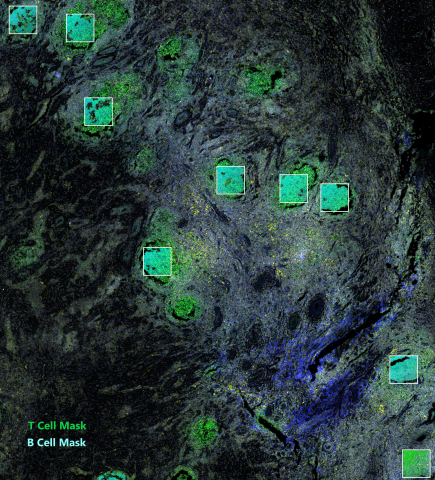SEATTLE--(BUSINESS WIRE)--NanoString Technologies, Inc. (NASDAQ:NSTG), a leading provider of life science tools for translational research, today announced the publication of two peer-reviewed studies using the GeoMx™ Digital Spatial Profiler (DSP) in the journal Nature. The two independent papers published by groups at the MD Anderson Cancer Center and Lund University used GeoMx DSP for deep molecular profiling of immune cells critical for understanding response to immunotherapy in patients with metastatic melanoma.
The first publication, “B-cells and tertiary lymphoid structures (TLS) contribute to immune checkpoint blockade response,” from the team of Dr. Jennifer Wargo at The University of Texas MD Anderson Cancer Center in Houston, TX. The study combines data from GeoMx DSP, RNA-sequencing, and mass cytometry to establish the presence of clonally expanded and memory-switched B-cells in patients responding to immune checkpoint blockade. This is the second publication by the Wargo group utilizing DSP, and it follows up observations in the earlier Nature Medicine paper that used the technology to identify B-cells as predictors of response to neoadjuvant immunotherapy (https://www.nature.com/articles/s41591-018-0197-1).
B-cells are adaptive immune cells that produce antibodies and mediate T-cell activation. Recently, the presence of B-cells in the tumor microenvironment has been recognized as a prognostic marker for immunotherapy response. However, the mechanisms by which they contribute to anti-tumor immunity are difficult to determine as their phenotype and behavior differ significantly based on location within the tumor. Notably, B-cells can concentrate in specialized lymphoid organs known as tertiary lymphoid structures (TLS). The B-cells, T-cells, and antigen presenting cells comprising the TLS have distinct phenotypes and functions when compared to non-TLS immune cells. Dissection of the roles and mechanisms that these cells play in the tumor immune environment requires the use of spatially driven multiplex technology such as GeoMx DSP.
“The multiplex GeoMx DSP platform enabled us to specifically define the immune phenotype of tumor-infiltrating and TLS-localized B-cells and T-cells in the tumor sample,” said Sarah Warren, Ph.D, Senior Director, Translational Science at NanoString. “By exclusively profiling the B-cells and T-cells within the TLS, we gained insights into the specific mechanisms by which these structures influence immunotherapy outcomes.”
The second study, “Tertiary lymphoid structures improve melanoma survival and immunotherapy response,” led by Dr. Göran Jönsson at the Lund University in Sweden, used the GeoMx DSP platform to conduct high-plex proteomic characterization of B- and T-cells in melanoma tumors with and without Tertiary Lymphoid Structures (TLS).
“We used the GeoMx platform to better understand the mechanism by which the presence of TLS lead to improved outcomes,” said Dr. Jönsson. “We found that infiltrating T-cells in tumors without TLS show a dysfunctional molecular phenotype, suggesting that distinct patterns of intratumoral adaptive immune activation may be partly driven by B-cells.”
“These concurrent studies demonstrate the ability of GeoMx DSP to deliver unique and impactful biological insights that advance the field on immuno-oncology,” said Brad Gray, NanoString’s president and chief executive officer.
The GeoMx Digital Spatial Profiler enables researchers to rapidly and quantitatively characterize tissue morphology with a high-throughput, high-plex RNA and protein profiling system that preserves samples for future analyses. NanoString and its collaborators have published DSP data in 12 peer-reviewed papers and presented DSP data in more than 35 abstracts at major scientific meetings, demonstrating the utility of DSP technology to address a wide range of biological questions in Formalin-Fixed Paraffin-Embedded (FFPE) tissues.
About NanoString Technologies, Inc.
NanoString Technologies is a leading provider of life science tools for translational research. The company’s nCounter® Analysis System is used in life sciences research and has been cited in more than 3,000 peer-reviewed publications. The nCounter Analysis System offers a cost-effective way to easily profile the expression of hundreds of genes, proteins, miRNAs, or copy number variations, simultaneously with high sensitivity and precision, facilitating a wide variety of basic research and translational medicine applications, including biomarker discovery and validation. The company’s GeoMx™ Digital Spatial Profiler enables highly-multiplexed spatial profiling of RNA and protein targets in a variety of sample types, including FFPE tissue sections.
For more information, please visit www.nanostring.com.
NanoString, NanoString Technologies, the NanoString logo, GeoMx, and nCounter are trademarks or registered trademarks of NanoString Technologies, Inc. in various jurisdictions.




